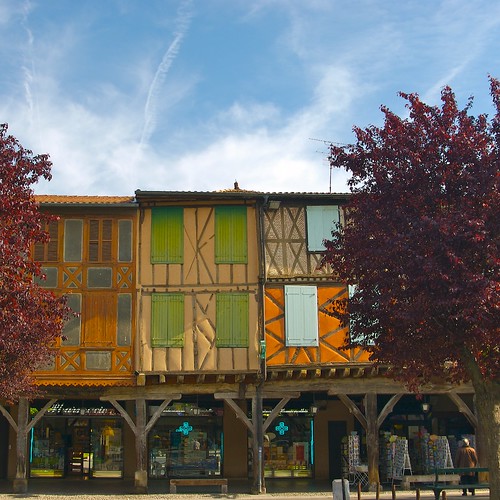Principalities and Paleolithic Cave Art (Act II, Scene II)

Béziers was nice, but we had to move on. We had an appointment to keep: we had reservations for a tour of the Grotte de Niaux, a cave in the Pyrénées with some exquisite Paleolithic cave art. The cave is not that far from Béziers (especially by American standards), but there aren't a lot of good roads that go there, so we had to take smaller highways for at least half the trip, which always worries me, since the quality of such roads can never be determined by a mere map. And having the 13:00 deadline didn't help matters either. But we left Béziers early enough that we could make a couple stops on the way. The most memorable was the small town of Mirepoix.

Mirepoix has a couple of interesting things going for it. The first, the cathedral of St. Maurice (woot woo!), is not only studded with gargoyles (and you should know by now that I am a sucker for a good gargoyle), but it also has the widest nave of any gothic church in all of France. Entering the church is very interesting, because of the lack of columns inside the broad room. The local legend says that this was so that the clergy could see everyone and be sure they weren't taking part in forbidden Cathar rituals. 

The main market square of Mirepoix is quite beautiful, as you can see from the pictures above. In addition to the pretty buildings, one particular building has faces carved into the ends of all of the wooden beams that date back to the 14th century. Some are in pretty bad shape, but many still look quite good, considering their age.
After poking around Mirepoix for a little while, we hit the road again for Niaux, the tiny town closest to the cave we were about to tour. 
Because of our common compulsion with being overpunctual, we were more than an hour early for the tour. Luckily, we brought a picnic lunch along and hung out at the cave entrance for a while.
There was this large rusty metallic structure with a great balcony looking over the valley below, filled with information about the Paleolithic culture (the Magdalenian culture) from this particular cave and the nearby caves in France. It was quite educational, despite the lack of non-French words.
Cameras were not allowed inside the cave, except to this point. The actual cave art was about 1 km inside. The cave has been sealed off and is climate controlled, and no lights are installed. We were issued a flashlight and follwed the guide (who was lightless) who has been doing this tour for so long he could not only get to the important points in the cave in the dark, but he could point out the puddles on the ground as well. The first scribbles on the walls we saw were actually grafitti from modern man (back to the 16th century of so) who visited the cave. Eventually we made it to the first real prehistoric markings - strange clusters of lines and dots. Researchers have no idea what these marks mean, but they must be significant because most caves in the area have similar markings. A few minutes later, we reached the awesome chamber that contains the most paleolithic art. It was quite amazing stuff really. The guide was really great, too. Since I was not able to take my own pictures, I bought slides from the gift shop. Here are a couple of the best specimens.


Our guide informed us that nobody really knows what the symbols mean, but he also insisted that most of the theories that I heard as a kid in school about art like this from caves such as Lascaux were probably wrong. Amazing what 20 years of research will turn up.
After we left the cave, we considered what to do next. There were several other prehistoric caves nearby that didn't require reservations. But Andorra was close too. I have always had this secret desire to visit all the tiny little European countries that nobody ever talks about (namely Andorra, San Marino & Malta, but really I want to visit every country...), so I just couldn't resist and we pointed the car southward & westward. We had to be very precise, because Andorra is so small, if were off by a fraction of a degree, we would miss it and end up in Spain. But we made it. I have proof:
And this sign isn't from a border town either, but from a town smack-dab in the middle of Andorra. To be honest, Andorra wasn't as exciting as I had hoped. It really is a beautiful place, in the middle of the mountains and all, but one has to really work hard to look past the massive condo developments and shopping centers to see it. 
Andorra's only industry is tourism relating to the mountains: Skiing in the winter, hiking & biking in the summer. We saw no castles perched on mountaintops or fancy palaces in the capital. 
Only one delapidated church gave any indication that Andorra isn't just another resort in Colorado or something. I was so shocked to find out that my romantic misconceptions of the Principality of Andorra, that Jeannette had to take a picture of the look on my face:

We did find some lovely nature away from crazy shopping plazas & resorts and enjoyed the mountain views while we reminisced about Colorado. 
After we filled up with tax-free gas (the main reason people come to Andorra outside of ski season), we drove the winding mountain road along the Têt Valley towards Perpignan, where we stayed for the night.
Labels: travel

0 Comments:
Post a Comment
Subscribe to Post Comments [Atom]
<< Home